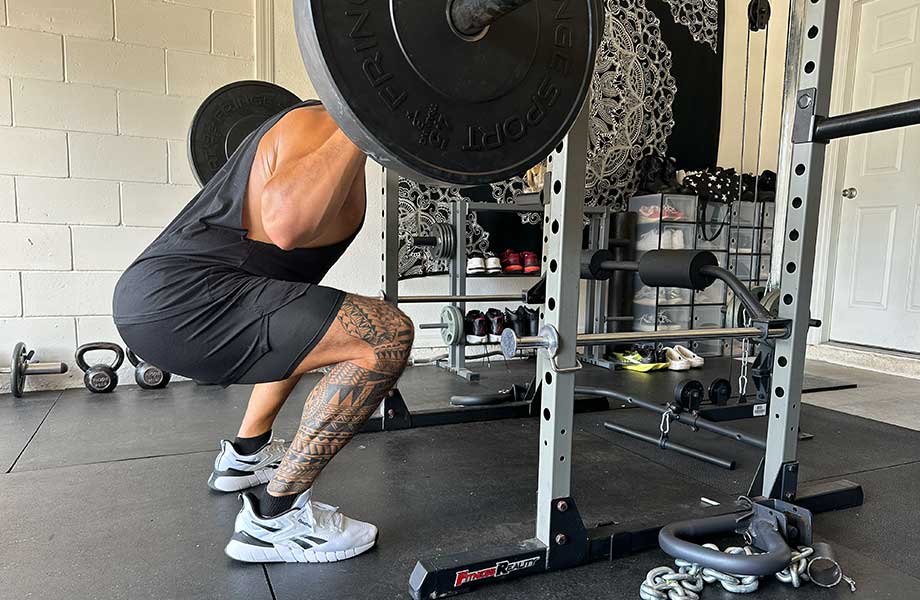We all know that exercise is good for us. Whenever we do it, we feel fitter than before we started. But sometimes, we question ourselves. Am I doing the right type of exercise? Am I prioritizing one form of exercise and not enough of another? Is there anything I’m missing that will help my overall fitness and well-being?
This is where the components of fitness come into play. Muscular strength, muscular endurance, cardiovascular endurance, flexibility, and body composition can all help you develop a training schedule that promotes good health and wellness. As a longtime certified personal trainer (CPT), I consider these fitness elements when putting together a program for a client.
I’ll begin this guide by describing the five components of fitness, why they’re important, and the benefits of each. Then, I’ll share how you can schedule your weekly training program to include all five components.
Without further ado, let’s get started!
What Are The Components Of Fitness?
There are five health-related components of fitness, including muscular strength, muscular endurance, cardiovascular endurance, flexibility, and body composition. Let’s do a deeper dive into each:
Muscular Strength
Muscular strength is defined as the body’s ability to generate force1. You can do this using barbells, dumbbells, kettlebells, the best resistance bands, or even your body weight. For strength building, your training program should include exercises that apply stress to your body. Over time, your body adapts to this stress, helping you to get stronger.
The benefits of increasing your muscular strength include stronger bones, improved athletic performance2, a lower risk of injury, improved cardiovascular endurance (see below), muscle hypertrophy, and more.

But how do you measure how strong you are? Test your one-rep max! Take the back squat as an example. See how much heavy weight you can squat for one repetition, then continue your strength training program as normal. In a few months, test yourself again. If your one-rep maximum has increased, you’ve become stronger.
Muscular Endurance
Muscle endurance is your ability to exert force over time without fatiguing your working muscle groups. Examples of muscular endurance exercises include planks, push-ups, kettlebell swings, calf raises, and sit-ups. Improving your muscular endurance can increase your functional strength and help you improve cardiovascular endurance activities such as running or biking.

In our guide on how many reps to build muscle, we discussed that you need lighter weights, higher reps, and reduced rest periods between sets to improve your muscular endurance. Put into practice, you’ll want to aim for two to three sets of each exercise and use a weight between 40% and 60% of your one-rep max3. You’ll want to do 15+ reps on each set and rest for between 30 and 60 seconds.
Cardiovascular Endurance
Next up is cardiovascular endurance (aka aerobic fitness or cardiorespiratory endurance). This refers to your body’s ability to perform aerobic exercise for an extended period of time. The better your cardio endurance, the more efficiently your heart and lungs can deliver oxygen and nutrients to your muscles.
The Centers for Disease Control and Prevention (CDC) recommends that adults need at least 150 minutes of moderate-intensity physical activity a week4. Health benefits of increasing your heart rate include less stress, better sleep, lower symptoms of anxiety and depression5, a lower risk of heart disease, the potential to assist with weight loss, regulating blood sugar of those with type 2 diabetes, and more.

RELATED: Benefits of Cardio
Cardiovascular endurance activities include running, cycling, swimming, walking, and more. The best way to build your cardio endurance is by performing more cardio. If you’re new to it, start small and build up your stamina gradually.
Flexibility
If you can do an exercise or a movement through its full range of motion without any pain or discomfort, the joints you’re working are considered flexible. Take the ab roll-up—a popular Pilates exercise—as an example. Try it right now. If you found it easy, great, but if not, you’ll likely need some more flexibility training.
The more flexible you are, the easier you’ll find your daily activities. If you’re tidying up your children’s toys after they’ve finished playing, it’s easier to continuously bend over and put them away. Lifting weights, doing cardio endurance exercises, and nearly everything in life is simpler when you have better flexibility.

To improve your flexibility, warm up before you exercise and perform static and dynamic stretches. A 2023 study6 concurs—it found that “A single bout of dynamic stretching (DS) and static stretching (SS) have similar short-term effects in improving hamstring ROM and length, while multiple bouts of SS can significantly improve hamstring ROM compared to DS.”
RELATED: 10 Best Warm-Up Exercises
Body Composition
In our guide to body fat percentage, we discussed that your body composition is how much fat (adipose tissue) you have compared to lean muscle mass. It’s a key component of fitness because having a high body fat percentage can lead to diabetes, cardiovascular disease, obstructive sleep apnea, certain cancers, and more7.
Your body mass index (BMI) is the quickest way to understand your body composition. However, this calculation doesn’t differentiate between fat mass and muscle mass, so it can often lead to inaccurate results. This is especially the case for those who have been resistance training for some time—it tells me that I’m obese!

RELATED: Body Recomposition Guide
Instead, you can use the following methods to calculate your body fat percentage:
- Dual-Energy X-ray Absorptiometry (DEXA scan): As the name suggests, two X-ray beams scan your body and give you your fat mass, muscle mass, and bone density. This method is extremely reliable but can be costly.
- Hydrostatic Weighing: Hydrostatic weighing (aka underwater weighing) compares your weight on land to your weight underwater. If you have a higher body fat percentage, you’ll float more when fully submerged.
- Bod Pod: This method uses a technique called air displacement plethysmography to determine your fat and muscle mass. You’ll be inside a specialized chamber that compares the changes in pressure between when you’re inside and when you’re not.
- Skinfold Calipers: You measure different areas of the body (for example, your arms, quadriceps, chest, and abdomen) to determine body fat percentage. This process isn’t as accurate as others on this list, especially if you do it yourself.
- Bioelectrical Impedance Analysis (BIA): Because fat, muscle, and bone have different levels of water content, you can use BIA scales to measure your body fat percentage. You can purchase one of the best smart scales, or use the BIA machine at your gym if there is one.
- Body Fat Calculator: You can simply enter your age, gender, weight, height, and waist, hip, and neck circumferences into an online calculator, and get an estimate of your body fat percentage. This isn’t the most accurate approach, but it is quick and easy.
Why Are the Components of Fitness Important?
Why do you need to know about the components of physical fitness? Your overall health depends on it, that’s why. All five components are key to a well-rounded fitness regimen, and not including one or more in your training routine may affect your quality of life.
For example, if you don’t include flexibility training, this will affect how much weight you can lift and how long you can perform cardio. It may also affect your post-workout recovery.

So, if you’re looking for a guide on how you might incorporate each fitness component, your training program could look like this:
- Monday: Muscular strength training
- Tuesday: Cardiovascular endurance and flexibility training
- Wednesday: Muscular endurance training
- Thursday: Cardiovascular endurance and flexibility training
- Friday: Muscular strength training
- Saturday: Rest
- Sunday: Rest
Additionally, you’ll want to measure your body composition once every month or two to ensure that you’re moving in the right direction.
Components Of Fitness: Final Thoughts
Altogether, there are five components of fitness, including muscular strength, muscular endurance, cardiovascular endurance, flexibility, and body composition. Each element is just as important as the other, but often, one or more are missed from weekly training programs.
Regularly incorporating the five components of fitness into your life can help you live healthier, age better, improve your mental health, be less prone to illnesses and disease, lower your blood pressure, and more.
Knowing and understanding the components of fitness doesn’t mean that you can’t do the types of exercise you enjoy. You can. You may, however, need to adjust what you do to incorporate the related components of physical fitness into your routine to get the most out of your training.
For example, if you’re like me and anaerobic training is what you enjoy most, cardio and flexibility training can complement your programming by helping you get stronger.
Components Of Fitness: FAQs
How do you remember the components of fitness?
To remember the components of fitness, use the acronym SECFB. This stands for the following:
-S = Strength
-E = Endurance
-C = Cardio
-F = Flexibility
-B = Body Composition
If this doesn’t work for you, think of an acronym that will. Alternatively, think about how you can link each component to daily activity (for example, strength is lifting objects, flexibility is bending or stretching, cardio is walking or cycling, endurance is carrying objects for a long amount of time, and body composition reflects your overall health).
What are the 5 physical fitness tests?
There are more than just five physical fitness tests that you can use to measure the different components of fitness. Examples include:
–Muscular strength: Test your one-rep maximum on back squats, deadlifts, bench presses, and more.
–Muscular endurance: Choose a muscular endurance exercise (for example, kettlebell swings or sit-ups), and see how many reps you can do in one minute.
–Cardiovascular endurance: Treadmill tests, beep tests, or step tests can be used to determine your cardiovascular endurance.
–Flexibility: The sit-and-reach test, trunk rotation test, and back-scratch test are all methods to test your flexibility.
–Body composition: Use skinfold calipers, a body fat calculator, or another method to determine your body fat percentage.
Which component of fitness is a push-up?
Push-ups or push-up variations can either be muscular strength or muscular endurance. If you’re doing high reps of push-ups (more than 15 reps) per set, it’s considered muscular endurance. However, push-ups are more likely to be categorized as muscular strength because most people will do between six and 12 reps on each set and rest for between one and two minutes.
References
- Kujala UM, Vaara JP, Kainulainen H, Vasankari T, Vaara E, Kyröläinen H. Associations of Aerobic Fitness and Maximal Muscular Strength With Metabolites in Young Men. JAMA Netw Open. 2019 Aug 2;2(8):e198265. doi: 10.1001/jamanetworkopen.2019.8265. PMID: 31441934; PMCID: PMC6714035.
- Suchomel TJ, Nimphius S, Stone MH. The Importance of Muscular Strength in Athletic Performance. Sports Med. 2016 Oct;46(10):1419-49. doi: 10.1007/s40279-016-0486-0. PMID: 26838985.
- Schoenfeld BJ, Grgic J, Van Every DW, Plotkin DL. Loading Recommendations for Muscle Strength, Hypertrophy, and Local Endurance: A Re-Examination of the Repetition Continuum. Sports (Basel). 2021 Feb 22;9(2):32. doi: 10.3390/sports9020032. PMID: 33671664; PMCID: PMC7927075.
- Centers for Disease Control and Prevention. (n.d.). Adult Activity: An Overview. CDC.
- Noetel M, Sanders T, Gallardo-Gómez D, Taylor P, Del Pozo Cruz B, van den Hoek D, Smith JJ, Mahoney J, Spathis J, Moresi M, Pagano R, Pagano L, Vasconcellos R, Arnott H, Varley B, Parker P, Biddle S, Lonsdale C. Effect of exercise for depression: systematic review and network meta-analysis of randomised controlled trials. BMJ. 2024 Feb 14;384:e075847. doi: 10.1136/bmj-2023-075847. Erratum in: BMJ. 2024 May 28;385:q1024. doi: 10.1136/bmj.q1024. PMID: 38355154; PMCID: PMC10870815.
- Cai P, Liu L, Li H. Dynamic and static stretching on hamstring flexibility and stiffness: A systematic review and meta-analysis. Heliyon. 2023 Jul 29;9(8):e18795. doi: 10.1016/j.heliyon.2023.e18795. PMID: 37560703; PMCID: PMC10407730.
- Fruh SM. Obesity: Risk factors, complications, and strategies for sustainable long-term weight management. J Am Assoc Nurse Pract. 2017 Oct;29(S1):S3-S14. doi: 10.1002/2327-6924.12510. PMID: 29024553; PMCID: PMC6088226.







